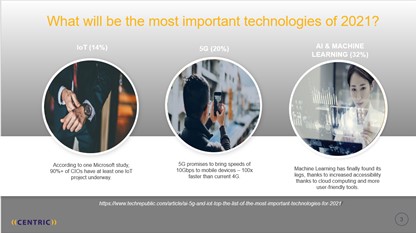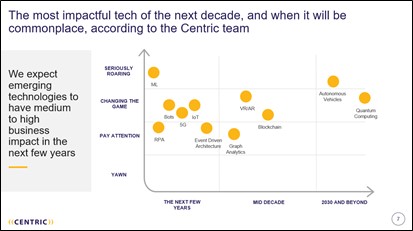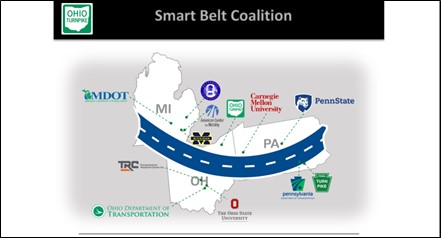We take a look at emerging tech trends for 2021 in our recap of a recent event. We also go beyond 2021 to predict where we’ll be in five to 10 years. Spoiler alert: autonomous vehicles.
If you were placing a big bet on breakout technology in 2021, what would it be? What if your bet was for a little longer horizon, say 2025 or 2030? Would you place your money on artificial intelligence (AI), autonomous vehicles (AV), quantum computing, or something else entirely?
That question, and others, guided our conversation with CIOs and technology leaders from mid-market to enterprise-size midwestern companies earlier this week. We hosted an informal session with our own Carmen Fontana and guest speaker Brian Kelly from the Ohio Turnpike Commission. They both shared their expertise and insights into what we can expect on the technology front.
Our Insights in 2021 Tech
Carmen, lead for our Modern Software Delivery practice, discussed several technologies she’s following in her role here at Centric as well as a few leading-edge technologies on behalf of clients. Prominent among those she’s working on and evaluating are quantum computing, machine learning (ML) and artificial intelligence.
According to a Tech Republic survey she shared, these technologies are likely to be most prominent in 2021: AI and Machine Learning, 5G and IoT.
Those results aligned with a quick survey of our CIO guests — they expected ML to be most prominent in 2021, followed by IoT.
But regarding the pandemic effect on tech deployment priorities this year, as one could imagine the focus was nearly unanimous on collaboration technologies, such as Microsoft Teams. Optimization of those tools will be a significant part of their efforts in 2021.
Our own technologists shared their views as well, weighing in on a more expansive list of technologies and envisioning impact and timeliness. Somewhat unsurprisingly, as technologists they expect everything to have a significant impact, but they were less certain about expectations of timing.
Carmen shared the following about quantum computing, “We’re in a very heavy research and development phase right now, but important advancement milestones are being hit more and more frequently. Mainstream adoption and impact are still at least eight to 10 years away, though.”
Our team’s views were pretty well-aligned with the CIOs and Tech Republic around ML, IoT and AI.
Personally, I think autonomous vehicles are going to arrive in prominence much more quickly than 2030. It depends on how one defines prominence though. Mainstream, consumer adoption is likely to be in that 2030 range or beyond, but the intersection of car subscription trends with rapidly developing autonomous vehicle technology likely will accelerate commercial adoption much more quickly than currently anticipated.
Looking at Tech Beyond 2021
In fact, our second presenter, Brian Kelley shared that the Ohio Turnpike Commission is well-down the path of evaluating autonomous vehicles for use on the turnpike.
Brian also shared a variety of interesting, innovative projects the Turnpike Commission is currently involved with. The commission has active Proof of Concept projects centered on AV primarily around trucking, snow removal and maintenance. They’re also working on sensor technologies reporting road conditions, over-the-road EV charging and developing a smart turnpike compact between Ohio, Pennsylvania and Michigan.
Even as a hardcore tech guy, Brian recognizes the importance of people in the equation. “It’s obviously critical to ensure technology innovation aligns to business objectives,” he said, “but it’s equally important to align innovation with human aspects of the business: user experience, personal impact, adoption velocity and more.”
Final Takeaways
Other interesting takeaways included data impacts, the relative position of the US in electric vehicles (EV) compared to other countries and who to watch for in the AV space. On data, the copious amounts of data produced by connected vehicles already strain cloud storage and compute capacity. So, while companies continue to build out capacity, more analytics will move to edge computing.
Nordic countries are outpacing the US in EV adoption almost across the board. On a per-capita basis, we may never catch them, but we’ll certainly exceed them on a unit basis.
Finally, Brian advises ignoring Uber, Tesla and others in the AV market — the ones to watch are GM, Ford and Mercedes based on their current and planned investments as well as their sheer capacity for investment.
I always enjoy these future tech view sessions. They’re interesting, intellectually stimulating, and I invariably come away learning something completely new.




